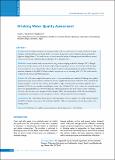Please use this identifier to cite or link to this item:
https://hdl.handle.net/20.500.14356/1938| Title: | Drinking Water Quality Assessment |
| Authors: | Aryal, J Gautam, B Sapkota, N |
| Citation: | AryalJ., GautamB., & SapkotaN. (2013). Drinking Water Quality Assessment. Journal of Nepal Health Research Council. https://doi.org/10.33314/jnhrc.v0i0.330 |
| Issue Date: | 2012 |
| Publisher: | Nepal Health Research Council |
| Article Type: | Original Article |
| Keywords: | Drinking water quality assessment Physico-chemical parameters Total coliform |
| Series/Report no.: | Sep-Dec, 2012;330 |
| Abstract: | Abstract Background: Drinking water quality is the great public health concern because it is a major risk factor for high incidence of diarrheal diseases in Nepal. In the recent years, the prevalence rate of diarrhoea has been found the highest in Myagdi district. This study was carried out to assess the quality of drinking water from different natural sources, reservoirs and collection taps at Arthunge VDC of Myagdi district. Methods: A cross-sectional study was carried out using random sampling method in Arthunge VDC of Myagdi district from January to June,2010. 84 water samples representing natural sources, reservoirs and collection taps from the study area were collected. The physico-chemical and microbiological analysis was performed following standards technique set by APHA 1998 and statistical analysis was carried out using SPSS 11.5. The result was also compared with national and WHO guidelines. Results :Out of 84 water samples (from natural source, reservoirs and tap water) analyzed, drinking water quality parameters (except arsenic and total coliform) of all water samples was found to be within the WHO standards and national standards.15.48% of water samples showed pH (13) higher than the WHO permissible guideline values. Similarly, 85.71% of water samples showed higher Arsenic value (72) than WHO value. Further, the statistical analysis showed no significant difference (P<0.05) of physico-chemical parameters and total coliform count of drinking water for collection taps water samples of winter (January, 2010) and summer (June, 2010). The microbiological examination of water samples revealed the presence of total coliform in 86.90% of water samples. Conclusions: The results obtained from physico-chemical analysis of water samples were within national standard and WHO standards except arsenic. The study also found the coliform contamination to be the key problem with drinking water. Keywords: drinking water quality assessment; physico-chemical parameters; total coliform. |
| Description: | Original Article |
| URI: | http://103.69.126.140:8080/handle/20.500.14356/1938 |
| ISSN: | Print ISSN: 1727-5482; Online ISSN: 1999-6217 |
| Appears in Collections: | Vol. 10 No. 3 Issue 22 Sep - Dec, 2012 |
Files in This Item:
| File | Description | Size | Format | |
|---|---|---|---|---|
| 330-Article Text-329-1-10-20130823.pdf | Fulltext Download | 163.44 kB | Adobe PDF |  View/Open |
Items in DSpace are protected by copyright, with all rights reserved, unless otherwise indicated.
